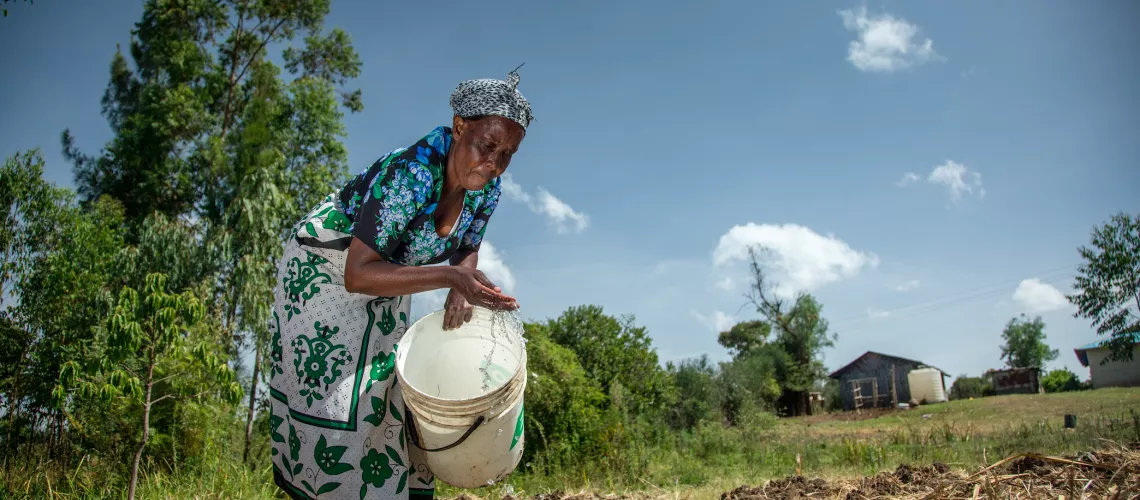Scaling up and accelerating farmer-led irrigation for COVID-19 recovery
By Joy Busolo & Regassa Ensermu Namara

The challenge to “build back better” requires that we take stock of what’s working and assess whether such approaches contribute to the future we want. In part one, we explored how farmer-led irrigation development (FLID) – a process in which small- and medium- scale farmers develop irrigation solutions tailored to their needs and priorities – can contribute to COVID-19 response and recovery by improving livelihoods, food security, and farmer and food system resilience. Here we take a closer look at strategies for scaling up and accelerating FLID.
The key is in the name. As farmers are the driving force behind it, efforts to promote FLID need to focus on supporting the farmers and creating an ecosystem in which they can thrive.
Financial and technological innovation alongside greater public, private, and civil society engagement are central to expanding FLID. Moreover, they provide clear pathways for responding to the pandemic, spurring recovery, and strengthening resilience.
Scaling up FLID requires the following.
- Catalyzing innovation: financing solutions for farmers
Accessing finance is a struggle for small- and medium-scale farmers – a notoriously credit-constrained group. While the farm-level financial case for investing in irrigation technology is strong, the upfront payment for equipment remains a key obstacle. Where loan financing can be obtained, seasonal cash flow fluctuations create a challenge for loan installment repayments, due to production and price volatility. While micro-financing models are numerous, rolling these out at scale is complex because irrigation technology is costly compared with more easily financed farm inputs, and the risks are difficult to assess without formal farm production records, which are often missing. Moreover, straightforward micro-credit solutions tend to ignore the reality that finance is just one constraint within a broader ecosystem of challenges: farmers also need access to value chains, affordable technologies, and the timely availability of inputs.
Innovative approaches can increase farmers’ access to irrigation financing. The strategic use of targeted subsidies, tailored cash-for-work programs, challenge funding, pay-as-you-go, grant schemes, and loan-underwriting can all help catalyze nascent markets by helping farmers overcome the initial hurdle of capital expenditure.
Where needed, subsidies from the government can be structured to increase technology uptake and further include the most vulnerable farmers. This approach also requires strengthening and de-risking the finance sector and its offer to farmers.
- Leveraging technology: creative solutions tailored to small-scale agriculture
Access to irrigation technology tends to be centralized in urban areas, with rural supply chains being weak in comparison. Complicating matters is the fact that farmer knowledge and exposure is often low, making it difficult to sort through the lower quality technologies that are increasingly crowding the market in the absence of country-level quality standards. Strengthening equipment supply chains, employing catalytic subsidies, reducing import costs through tariff policy, and implementing appropriate quality standards can help increase access to these transformative technologies.
Big data and disruptive tech can also help solve some traditional problems. Remote sensing is already being used effectively to identify water stress and production patterns, provide bespoke advisory services to subscribing farmers, as well as document shifts after adoption of technology and improved practices. Social and mass media, meanwhile, increasingly enable ideation, lesson learning, and linking of farmers to data, services, markets and relevant extension; they can also help close feedback loops. Both the private sector and farmers see an interest in developing new, robust, adapted technology to address long-term sustainability concerns.
- Strengthening partnership: public and private sector collaboration
The private sector is central in creating jobs, ensuring sustainable supply chains, driving rapid innovation, and mobilizing finance; and it’s present throughout the irrigated value chain. This is less a driving and more a facilitating role: creating the enabling environment by regulating water use and technology, targeting subsidies, and developing appropriate policy.
The sheer number of stakeholders, in combination with the transaction costs involved in working with rural farmers, has posed a challenge to the scaling up of FLID. Robust partnership platforms that bring together stakeholders from across the irrigation value chain are needed to better prepare and align the demand for irrigation support, financial and otherwise, using a bottom-up approach. Likewise, cooperative networks play a vital role in facilitating knowledge sharing, exposing farmers to new technologies, and establishing critical supplier networks.
- Formalizing FLID: institutional adaptation and innovation
FLID is inevitably a feature of basin regulation due to its relatively low profile on government databases, but its significant contribution to abstraction totals. However, existing permit-based administrative systems are unsuited to accurately capturing and regulating FLID, since they were designed to regulate a limited number of large water users. By contrast, FLID involves millions of low-volume micro-abstractions, many of which are impermanent. These could include clustered or group-permitting, leveraging new technologies to monitor water abstractions, simplifying processes to ensure access, and innovating hybrid-law approaches that build on traditions, norms, and local by-laws.
Learning from farmers on the frontlines
The 2030 Water Resources Group (2030 WRG) is working to unite diverse groups with a common interest in the sustainable management of water resources; it’s a leading global partnership among the public and private sectors and civil society that supports country-level collaboration. 2030 WRG is collaborating with the World Bank and the Farmer-led Irrigation Initiative to unlock the full potential of agriculture through FLID.
Promoting FLID is not a one-size-fits-all undertaking, but involves learning from farmers about the solutions they have developed to solve the challenges specific to their environment, then bringing those to scale.
The question of “how to build back better” in COVID-19 recovery looms large and will require innovation and cooperation across many fronts.
